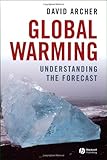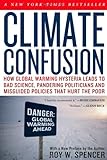|
|
Help |
| Home - Science - Global Warming (Books) | |
e99 Online Shopping Mall
|
|
Help |
| Home - Science - Global Warming (Books) | |
| 1-20 of 99 | Next 20 |
click price to see details click image to enlarge click link to go to the store
| 1. The Great Global Warming Blunder: How Mother Nature Fooled the World's Top Climate Scientists by Roy W Spencer | |
 | Hardcover: 180
Pages
(2010-04-13)
list price: US$23.95 -- used & new: US$14.63 (price subject to change: see help) Asin: 1594033730 Average Customer Review: Canada | United Kingdom | Germany | France | Japan |
|
Editorial Review Product Description Customer Reviews (32)
| |
| 2. The Discovery of Global Warming: Revised and Expanded Edition (New Histories of Science, Technology, and Medicine) by Spencer R. Weart | |
 | Paperback: 240
Pages
(2008-10-31)
list price: US$17.95 -- used & new: US$12.00 (price subject to change: see help) Asin: 067403189X Average Customer Review: Canada | United Kingdom | Germany | France | Japan |
|
Editorial Review Product Description The award-winning book is now revised and expanded. In 2001 an international panel of distinguished climate scientists announced that the world was warming at a rate without precedent during at least the last ten millennia, and that warming was caused by the buildup of greenhouse gases from human activity. The story of how scientists reached that conclusion—by way of unexpected twists and turns—was the story Spencer Weart told in The Discovery of Global Warming. Now he brings his award-winning account up to date, revised throughout to reflect the latest science and with a new conclusion that shows how the scientific consensus caught fire among the general world public, and how a new understanding of the human meaning of climate change spurred individuals and governments to action. Customer Reviews (29)
| |
| 3. The Politically Incorrect Guide to Global Warming (and Environmentalism) by Christopher C. Horner | |
 | Paperback: 366
Pages
(2007-02-12)
list price: US$19.95 -- used & new: US$3.00 (price subject to change: see help) Asin: 1596985011 Average Customer Review: Canada | United Kingdom | Germany | France | Japan |
|
Editorial Review Product Description Customer Reviews (285)
| |
| 4. Global Warming: The Complete Briefing by John Houghton | |
 | Paperback: 456
Pages
(2009-04-27)
list price: US$59.00 -- used & new: US$29.50 (price subject to change: see help) Asin: 0521709164 Average Customer Review: Canada | United Kingdom | Germany | France | Japan |
|
Editorial Review Product Description Customer Reviews (13)
| |
| 5. An Inconvenient Truth: The Crisis of Global Warming by Al Gore | |
 | Paperback: 192
Pages
(2007-04-10)
list price: US$16.00 -- used & new: US$3.47 (price subject to change: see help) Asin: 0670062723 Average Customer Review: Canada | United Kingdom | Germany | France | Japan |
|
Editorial Review Product Description Dramatic full-color photos, illustrations, and graphs combine with Gore's effective and clear writing to explain global warming in very real terms: what it is, what causes it, and what will happen if we continue to ignore it. An Inconvenient Truth will change the way young people understand global warming and hopefully inspire them to help change the course of history. Customer Reviews (39)
| |
| 6. Down-to-Earth Guide To Global Warming by Laurie David and Cambria Gordon | |
 | Paperback: 128
Pages
(2007-09-01)
list price: US$15.99 -- used & new: US$2.71 (price subject to change: see help) Asin: 0439024943 Average Customer Review: Canada | United Kingdom | Germany | France | Japan |
|
Editorial Review Product Description Customer Reviews (38)
| |
| 7. Global Warming: Understanding the Forecast by David Archer | |
 | Paperback: 288
Pages
(2006-12-11)
-- used & new: US$35.99 (price subject to change: see help) Asin: 1405140399 Average Customer Review: Canada | United Kingdom | Germany | France | Japan |
|
Editorial Review Product Description Customer Reviews (7)
| |
| 8. A Kids' Guide to Climate Change & Global Warming: How to Take Action! by Cathryn Berger Kaye M.A. | |
 | Paperback: 48
Pages
(2009-04-20)
list price: US$6.95 -- used & new: US$3.48 (price subject to change: see help) Asin: 1575423235 Average Customer Review: Canada | United Kingdom | Germany | France | Japan |
|
Editorial Review Product Description Customer Reviews (1)
| |
| 9. Unstoppable Global Warming: Every 1,500 Years, Updated and Expanded Edition by S. Fred Singer, Dennis T. Avery | |
 | Paperback: 264
Pages
(2007-10-22)
list price: US$21.95 -- used & new: US$4.78 (price subject to change: see help) Asin: 0742551245 Average Customer Review: Canada | United Kingdom | Germany | France | Japan |
|
Editorial Review Product Description Customer Reviews (198)
| |
| 10. The Bad Science and Bad Policy of Obama's Global Warming Agenda (Encounter Broadsides) by Roy W. Spencer | |
 | Paperback: 48
Pages
(2010-01-26)
list price: US$5.99 -- used & new: US$2.18 (price subject to change: see help) Asin: 1594034826 Average Customer Review: Canada | United Kingdom | Germany | France | Japan |
|
Editorial Review Product Description Customer Reviews (2)
| |
| 11. Climate Confusion: How Global Warming Hysteria Leads to Bad Science, Pandering Politicians and Misguided Policies That Hurt the Poor by Roy W. Spencer | |
 | Paperback: 215
Pages
(2010-01-12)
list price: US$14.95 -- used & new: US$9.10 (price subject to change: see help) Asin: 1594033455 Average Customer Review: Canada | United Kingdom | Germany | France | Japan |
|
Editorial Review Product Description Customer Reviews (112)
| |
| 12. Climate Cover-Up: The Crusade to Deny Global Warming by James Hoggan | |
 | Paperback: 240
Pages
(2009-09-29)
list price: US$15.00 -- used & new: US$8.66 (price subject to change: see help) Asin: 1553654854 Average Customer Review: Canada | United Kingdom | Germany | France | Japan |
|
Editorial Review Product Description Customer Reviews (71)
| |
| 13. Global Warming and Climate Change Demystified by Jerry Silver | |
 | Paperback: 289
Pages
(2008-01-30)
list price: US$19.95 -- used & new: US$9.53 (price subject to change: see help) Asin: 0071502408 Average Customer Review: Canada | United Kingdom | Germany | France | Japan |
|
Editorial Review Product Description A non-heated discussion on global warming and climate change Interested in getting to the core of the reasons for the Earth's changing climate? Want an accurate reading on the science behind global warming? Here's your gauge! This easy-to-follow guide offers a temperate view of this hot topic. Global Warming & Climate Change Demystified starts by looking at scientific data gathered from weather instruments, satellite telemetry, ice cores, and coral sections that reveal how the Earth's temperature is changing. The book goes on to examine the causes of climate change, including both natural processes and human-generated greenhouse gases. Finally, the consequences of global warming are discussed and a wide variety of viable solutions that can be implemented by individuals as well as society as a whole are presented. Complete with end-of-chapter quizzes and a final review to test your knowledge, this book will teach you the fundamentals of global warming and climate change in an unbiased and thorough manner. This fast and easy guide offers: Simple enough for a beginner, but challenging enough for an advanced student, Global Warming & Climate Change Demystified is your shortcut to understanding this important and timely issue. Customer Reviews (2)
| |
| 14. Cool It: The Skeptical Environmentalist's Guide to Global Warming (Vintage) by Bjorn Lomborg | |
 | Paperback: 272
Pages
(2008-08-12)
list price: US$14.95 -- used & new: US$6.39 (price subject to change: see help) Asin: 030738652X Average Customer Review: Canada | United Kingdom | Germany | France | Japan |
|
Editorial Review Product Description Bjorn Lomborg argues that many of the elaborate and staggeringly expensive actions now being considered to meet the challenges of global warming ultimately will have little impact on the world’s temperature. He suggests that rather than focusing on ineffective solutions that will cost us trillions of dollars over the coming decades, we should be looking for smarter, more cost-effective approaches (such as massively increasing our commitment to green energy R&D) that will allow us to deal not only with climate change but also with other pressing global concerns, such as malaria and HIV/AIDS. And he considers why and how this debate has fostered an atmosphere in which dissenters are immediately demonized. Customer Reviews (134)
| |
| 15. Global Warming: A Very Short Introduction (Very Short Introductions) by Mark Maslin | |
 | Paperback: 176
Pages
(2009-01-15)
list price: US$11.95 -- used & new: US$6.39 (price subject to change: see help) Asin: 0199548242 Average Customer Review: Canada | United Kingdom | Germany | France | Japan |
|
Editorial Review Product Description Customer Reviews (9)
| |
| 16. The Deniers: The World Renowned Scientists Who Stood Up Against Global Warming Hysteria, Political Persecution, and Fraud**And those who are too fearful to do so by Lawrence Solomon | |
 | Hardcover: 240
Pages
(2008-04-01)
list price: US$27.95 -- used & new: US$9.99 (price subject to change: see help) Asin: 0980076315 Average Customer Review: Canada | United Kingdom | Germany | France | Japan |
Customer Reviews (83)
| |
| 17. Man-Made Global Warming Hoax by Richard C. Huseman, Ph.D. | |
 | Paperback: 204
Pages
(2010-08-13)
list price: US$31.95 -- used & new: US$31.95 (price subject to change: see help) Asin: 0984152512 Canada | United Kingdom | Germany | France | Japan |
|
Editorial Review Product Description | |
| 18. Red Hot Lies: How Global Warming Alarmists Use Threats, Fraud, and Deception to Keep You Misinformed by Christopher C. Horner | |
 | Hardcover: 407
Pages
(2008-11-11)
list price: US$27.95 -- used & new: US$5.30 (price subject to change: see help) Asin: 1596985380 Average Customer Review: Canada | United Kingdom | Germany | France | Japan |
|
Editorial Review Product Description Shocking, frank, and illuminating, Chris Horner's Red Hot Lies explodes as manymyths as Al Gore promotes. Customer Reviews (60)
| |
| 19. Global Warming by Seymour Simon | |
 | Hardcover: 32
Pages
(2010-02-23)
list price: US$17.99 -- used & new: US$10.33 (price subject to change: see help) Asin: 0061142506 Average Customer Review: Canada | United Kingdom | Germany | France | Japan |
|
Editorial Review Product Description Earth's climate has always varied, but it is now changing more rapidly than at any other time in recent centuries. The climate is very complex, and many factors play important roles in determining how it changes. Why is the climate changing? Could Earth be getting warmer by itself? Are people doing things that make the climate warmer? Award-winning science writer Seymour Simon teams up with the Smithsonian Institution to give you a full-color photographic introduction to the causes and effects of global warming and climate change. Customer Reviews (4)
| |
| 20. Heaven and Earth: Global Warming, the Missing Science by Ian Plimer | |
 | Paperback: 504
Pages
(2009-07-25)
list price: US$21.95 -- used & new: US$10.88 (price subject to change: see help) Asin: 1589794729 Average Customer Review: Canada | United Kingdom | Germany | France | Japan |
|
Editorial Review Product Description Customer Reviews (114)
| |
| 1-20 of 99 | Next 20 |